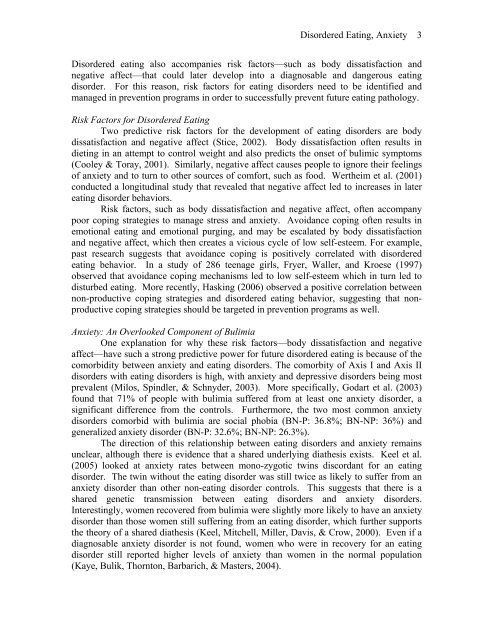The Secret Society: Descendants of Crypto-Jews in the San Antonio ...
The Secret Society: Descendants of Crypto-Jews in the San Antonio ...
The Secret Society: Descendants of Crypto-Jews in the San Antonio ...
Create successful ePaper yourself
Turn your PDF publications into a flip-book with our unique Google optimized e-Paper software.
Disordered Eat<strong>in</strong>g, Anxiety 3<br />
Disordered eat<strong>in</strong>g also accompanies risk factors—such as body dissatisfaction and<br />
negative affect—that could later develop <strong>in</strong>to a diagnosable and dangerous eat<strong>in</strong>g<br />
disorder. For this reason, risk factors for eat<strong>in</strong>g disorders need to be identified and<br />
managed <strong>in</strong> prevention programs <strong>in</strong> order to successfully prevent future eat<strong>in</strong>g pathology.<br />
Risk Factors for Disordered Eat<strong>in</strong>g<br />
Two predictive risk factors for <strong>the</strong> development <strong>of</strong> eat<strong>in</strong>g disorders are body<br />
dissatisfaction and negative affect (Stice, 2002). Body dissatisfaction <strong>of</strong>ten results <strong>in</strong><br />
diet<strong>in</strong>g <strong>in</strong> an attempt to control weight and also predicts <strong>the</strong> onset <strong>of</strong> bulimic symptoms<br />
(Cooley & Toray, 2001). Similarly, negative affect causes people to ignore <strong>the</strong>ir feel<strong>in</strong>gs<br />
<strong>of</strong> anxiety and to turn to o<strong>the</strong>r sources <strong>of</strong> comfort, such as food. Wer<strong>the</strong>im et al. (2001)<br />
conducted a longitud<strong>in</strong>al study that revealed that negative affect led to <strong>in</strong>creases <strong>in</strong> later<br />
eat<strong>in</strong>g disorder behaviors.<br />
Risk factors, such as body dissatisfaction and negative affect, <strong>of</strong>ten accompany<br />
poor cop<strong>in</strong>g strategies to manage stress and anxiety. Avoidance cop<strong>in</strong>g <strong>of</strong>ten results <strong>in</strong><br />
emotional eat<strong>in</strong>g and emotional purg<strong>in</strong>g, and may be escalated by body dissatisfaction<br />
and negative affect, which <strong>the</strong>n creates a vicious cycle <strong>of</strong> low self-esteem. For example,<br />
past research suggests that avoidance cop<strong>in</strong>g is positively correlated with disordered<br />
eat<strong>in</strong>g behavior. In a study <strong>of</strong> 286 teenage girls, Fryer, Waller, and Kroese (1997)<br />
observed that avoidance cop<strong>in</strong>g mechanisms led to low self-esteem which <strong>in</strong> turn led to<br />
disturbed eat<strong>in</strong>g. More recently, Hask<strong>in</strong>g (2006) observed a positive correlation between<br />
non-productive cop<strong>in</strong>g strategies and disordered eat<strong>in</strong>g behavior, suggest<strong>in</strong>g that nonproductive<br />
cop<strong>in</strong>g strategies should be targeted <strong>in</strong> prevention programs as well.<br />
Anxiety: An Overlooked Component <strong>of</strong> Bulimia<br />
One explanation for why <strong>the</strong>se risk factors—body dissatisfaction and negative<br />
affect—have such a strong predictive power for future disordered eat<strong>in</strong>g is because <strong>of</strong> <strong>the</strong><br />
comorbidity between anxiety and eat<strong>in</strong>g disorders. <strong>The</strong> comorbity <strong>of</strong> Axis I and Axis II<br />
disorders with eat<strong>in</strong>g disorders is high, with anxiety and depressive disorders be<strong>in</strong>g most<br />
prevalent (Milos, Sp<strong>in</strong>dler, & Schnyder, 2003). More specifically, Godart et al. (2003)<br />
found that 71% <strong>of</strong> people with bulimia suffered from at least one anxiety disorder, a<br />
significant difference from <strong>the</strong> controls. Fur<strong>the</strong>rmore, <strong>the</strong> two most common anxiety<br />
disorders comorbid with bulimia are social phobia (BN-P: 36.8%; BN-NP: 36%) and<br />
generalized anxiety disorder (BN-P: 32.6%; BN-NP: 26.3%).<br />
<strong>The</strong> direction <strong>of</strong> this relationship between eat<strong>in</strong>g disorders and anxiety rema<strong>in</strong>s<br />
unclear, although <strong>the</strong>re is evidence that a shared underly<strong>in</strong>g dia<strong>the</strong>sis exists. Keel et al.<br />
(2005) looked at anxiety rates between mono-zygotic tw<strong>in</strong>s discordant for an eat<strong>in</strong>g<br />
disorder. <strong>The</strong> tw<strong>in</strong> without <strong>the</strong> eat<strong>in</strong>g disorder was still twice as likely to suffer from an<br />
anxiety disorder than o<strong>the</strong>r non-eat<strong>in</strong>g disorder controls. This suggests that <strong>the</strong>re is a<br />
shared genetic transmission between eat<strong>in</strong>g disorders and anxiety disorders.<br />
Interest<strong>in</strong>gly, women recovered from bulimia were slightly more likely to have an anxiety<br />
disorder than those women still suffer<strong>in</strong>g from an eat<strong>in</strong>g disorder, which fur<strong>the</strong>r supports<br />
<strong>the</strong> <strong>the</strong>ory <strong>of</strong> a shared dia<strong>the</strong>sis (Keel, Mitchell, Miller, Davis, & Crow, 2000). Even if a<br />
diagnosable anxiety disorder is not found, women who were <strong>in</strong> recovery for an eat<strong>in</strong>g<br />
disorder still reported higher levels <strong>of</strong> anxiety than women <strong>in</strong> <strong>the</strong> normal population<br />
(Kaye, Bulik, Thornton, Barbarich, & Masters, 2004).
















